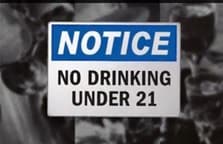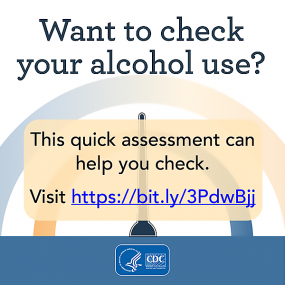Underage Drinking
Underage alcohol consumption is common in the United States and can have harmful outcomes. A comprehensive approach that includes effective policy strategies can prevent underage drinking and related harms.
Underage drinking is a significant public health problem in the U.S. Excessive drinking is responsible for about 4,000 deaths and more than 240,000 years of potential life lost among people under age 21 each year.1 Underage drinking cost the U.S. $24 billion in 2010.2
Underage Drinking is Common
Alcohol is the most commonly used substance among young people in the U.S.3
The 2021 Youth Risk Behavior Survey3 found that among high school students, during the past 30 days
- 23% drank alcohol.
- 11% binge drank.
- 5% of drivers drove after drinking alcohol.
- 14% rode with a driver who had been drinking alcohol.
Rates of current and binge drinking among high school students have generally been declining in recent decades. Although males historically had higher rates, in 2019 and 2021, female high school students were more likely to drink alcohol and binge drink than male high school students.3,4
Underage Drinking is Dangerous
Youth who drink alcohol are more likely to experience4-7
- School problems, such as higher rates of absences or lower grades.
- Social problems, such as fighting or lack of participation in youth activities.
- Legal problems, such as arrest for driving or physically hurting someone while drunk.
- Physical problems, such as hangovers or illnesses.
- Unwanted, unplanned, and unprotected sexual activity.
- Disruption of normal growth or sexual development.
- Physical and sexual violence.
- Increased risk of suicide and homicide.
- Alcohol-related motor vehicle crashes and other unintentional injuries, such as burns, falls, or drowning.
- Memory problems.
- Misuse of other substances.
- Changes in brain development that may have life-long effects.
- Alcohol poisoning.
In general, the risk of youth experiencing these problems is greater for those who binge drink than for those who do not binge drink.6,7
Early initiation of drinking is associated with development of an alcohol use disorder later in life.8
Underage Drinking is Associated with Adult Drinking
Studies show a relationship between underage drinking behaviors and the drinking behaviors of adult relatives, adults in the same household, and adults in the same community and state.
- There is a relationship between youth and adult drinking, including binge drinking, in states and communities.9-11 A 5% increase in binge drinking among adults in a community is associated with a 12% increase in the chance of underage drinking.10
- Among adolescents whose peers drink alcohol, those whose parents binge drink are more likely to drink alcohol than those whose parents do not.12
Underage Drinking is Preventable
State alcohol policy environments influence underage drinking, as well as excessive drinking among adults. Comprehensive approaches that include effective population-level policy strategies can reduce underage drinking.10,13,14 The Community Preventive Services Task Force recommends several effective strategies for preventing excessive drinking,15 including:
- Increasing alcohol taxes.
- Having commercial host (“dram shop”) liability laws.
- Regulating the number and concentration of alcohol outlets.
- Enforcing laws prohibiting alcohol sales to minors.
The Surgeon General’s Report on Alcohol, Drugs, and Health describes other strategies that can complement effective alcohol policies, such as national media campaigns targeting youth and adults, reducing youth exposure to alcohol advertising, and the development of comprehensive community-based programs.5 Read more about the prevention of excessive alcohol use, including underage drinking.
- Centers for Disease Control and Prevention. Alcohol-Related Disease Impact Application website. Accessed April 16, 2024.
- Sacks JJ, Gonzales KR, Bouchery EE, Tomedi LE, Brewer RD. 2010 national and state costs of excessive alcohol consumption. Am J Prev Med 2015; 49:e73–e79.
- Centers for Disease Control and Prevention. 2021 Youth Risk Behavior Survey Data. Available at: https://www.cdc.gov/healthyyouth/data/yrbs/index.htm. Accessed on September 13, 2023.
- Jones CM, Clayton HB, Deputy NP, Roehler, DR, Ko JY, Esser MB, Brookmeyer KA, Hertz MF. Prescription opioid misuse and use of alcohol and other substances among high school students — Youth Risk Behavior Survey, United States, 2019. MMWR Suppl 2020;69(Suppl-1):38–46.
- U.S. Department of Health and Human Services (HHS), Office of the Surgeon General. Facing addiction in America: The Surgeon General’s report on alcohol, drugs, and health. Washington, DC: HHS, 2016.
- Miller JW, Naimi TS, Brewer RD, Jones SE. Binge drinking and associated health risk behaviors among high school students. Pediatrics 2007;119:76–85.
- Esser MB, Guy GP, Zhang K, Brewer RD. Binge drinking and prescription opioid misuse in the U.S., 2012-2014. Am J Prev Med 2019;57,197-208.
- Buchmann AF, Schmid B, Blomeyer D, et al. Impact of age at first drink on vulnerability to alcohol-related problems: Testing the marker hypothesis in a prospective study of young adults. J Psychiatr Res 2009;43:1205–1212.
- Nelson DE, Naimi TS, Brewer RD, Nelson HA. State alcohol-use estimates among youth and adults, 1993–2005. Am J Prev Med 2009;36:218–224
- Xuan Z, Nelson TF, Heeren T, et al. Tax policy, adult binge drinking, and youth alcohol consumption in the United States. Alcohol Clin Exp Res 2013;37:1713–1719.
- Paschall MJ, Lipperman-Kreda S, Grube JW. Effects of the local alcohol environment on adolescents’ drinking behaviors and beliefs. Addiction 2014;109:407–416.
- Olson JS, Crosnoe R. The interplay of peer, parent, and adolescent drinking. Soc Sci Q 2018;99:1349–1362.
- Xuan Z, Blanchette JG, Nelson TF, et al. Youth drinking in the United States: Relationships with alcohol policies and adult drinking. Pediatrics 2015;136:18–27.
- Blanchette JG, Lira MC, Heeren TC, Naimi TS. Alcohol policies in U.S. states, 1999–2018. J Stud Alcohol Drugs. 2020;81:58–67.
- Excessive Alcohol Consumption. The Guide to Community Preventive Services website. Accessed September 16, 2022.

